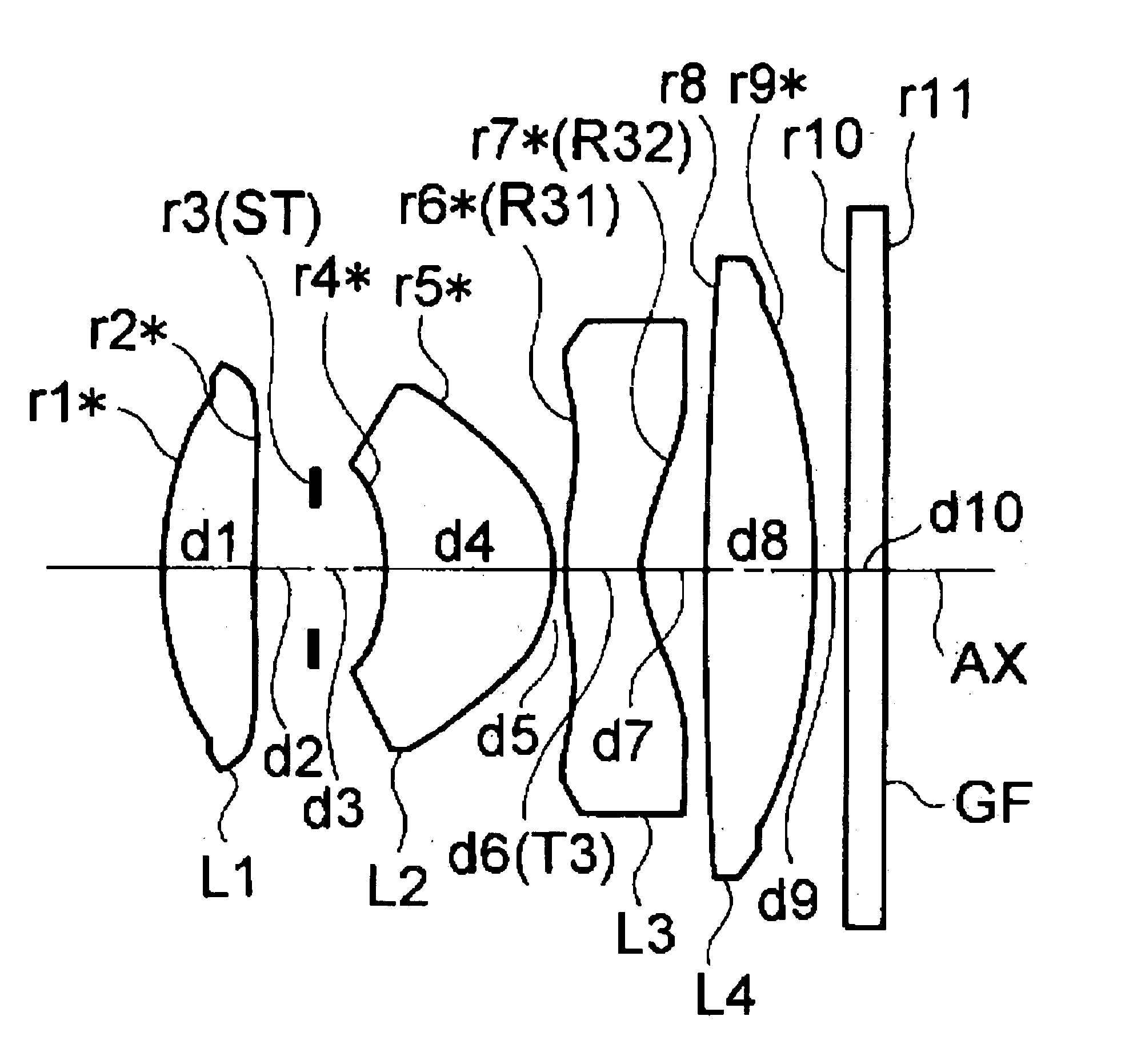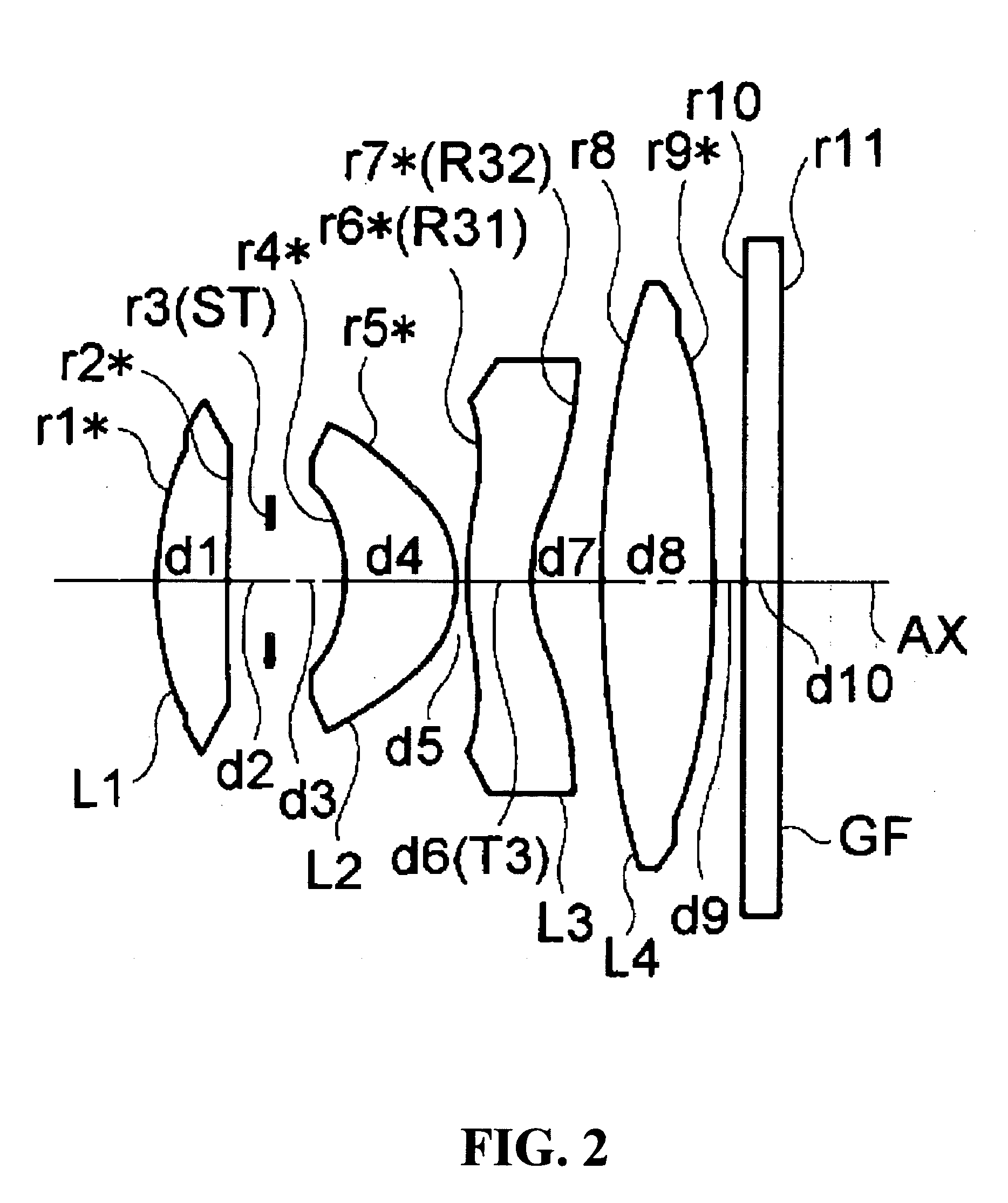Image pickup lens system
a technology of image pickup and lens, which is applied in the field of can solve the problems of increased performance required for the image pickup lens system, affecting the brightness of the image, and the lens provided in front of the solid-state image pickup device not exerting enough focusing performance, etc., and achieves compact size and good optical performance.
- Summary
- Abstract
- Description
- Claims
- Application Information
AI Technical Summary
Benefits of technology
Problems solved by technology
Method used
Image
Examples
example 1
f=5.795, FNO=3.0
[0071]
radius ofaxialrefractiveAbbecurvaturedistanceindexnumberr1* = 4.228d1 = 1.085N1 = 1.53048ν1 = 55.72(L1)r2* = 47.641d2 = 0.750r3 = ∞(ST)d3 = 0.864r4* = −2.537d4 = 2.024N2 = 1.53048ν2 = 55.72(L2)r5* = −1.495d5 = 0.100r6* = 3.587(=R31)d6 =N3 = 1.58340ν3 = 30.23(L3)0.957(=T3)r7* = 1.531(=R32)d7 = 0.737r8 = 38.075d8 = 1.393N4 = 1.53048ν4 = 55.72(L4)r9* = −15.079d9 = 0.400r10 = ∞d10 = 0.500N5 = 1.51680ν5 = 64.20(GF)r11 = ∞
[aspheric surface data of 1st surface (r1)]
ε = 0.94665, A4 = 0.31003 × 10−2, A6 = −0.15830 × 10−3,
A8 = 0.36453 × 10−4, A10 = −0.20033 × 10−4
[aspheric surface data of 2nd surface (r2)]
ε = 0.16000 × 102, A4 = 0.72239 × 10−2, A6 = −0.41496 × 10−2,
A8 = 0.10963 × 10−2, A10 = −0.15453 × 10−3
[aspheric surface data of 4th surface (r4)]
ε = 0.68121, A4 = −0.67380 × 10−2, A6 = −0.45004 × 10−1,
A8 = 0.29782 × 10−1, A10 = −0.57264 × 10−2
[aspheric surface data of 5th surface (r5)]
ε = 0.30436, A4 = 0.11711 × 10−1, A6 = −0.16024 × 10−2,
A8 = −0.71809 × 10−3, A...
example 2
f=5.667, FNO=3.6
[0072]
radius ofaxialrefractiveAbbecurvaturedistanceindexnumberr1* = 3.863d1 = 0.941N1 = 1.53048ν1 = 55.72(L1)r2* = 29.355d2 = 0.535r3 = ∞(ST)d3 = 1.011r4* = −1.939d4 = 1.381N2 = 1.53048ν2 = 55.72(L2)r5* = −1.381d5 = 0.100r6* = 3.199(=R31)d6 =N3 = 1.58340ν3 = 30.23(L3)0.859(=T3)r7* = 1.562(=R32)d7 = 0.905r8 = 13.704d8 = 1.449N4 = 1.53048ν4 = 55.72(L4)r9* = −31.652d9 = 0.400r10 = ∞d10 = 0.500N5 = 1.51680ν5 = 64.20(GF)r11 = ∞
[aspheric surface data of 1st surface (r1)]
ε = 0.94062, A4 = 0.32704 × 10−2, A6 = −0.94100 × 10−4,
A8 = 0.97547 × 10−4, A10 = −0.81541 × 10−4
[aspheric surface data of 2nd surface (r2)]
ε = 0.15824 × 102, A4 = 0.77595 × 10−2, A6 = −0.46503 × 10−2,
A8 = 0.97366 × 10−3, A10 = −0.18223 × 10−3
[aspheric surface data of 4th surface (r4)]
ε = 0.10419 × 10, A4 = −0.70554 × 10−2, A6 = −0.38890 × 10−1,
A8 = 0.27836 × 10−1, A10 = −0.37367 × 10−2
[aspheric surface data of 5th surface (r5)]
ε = 0.32762, A4 = 0.99396 × 10−2, A6 = −0.48551 × 10−2,
A8 = −0.50507 × 10...
example 3
f=5.761, FNO=3.6
[0073]
radius ofaxialrefractiveAbbecurvaturedistanceindexnumberr1* = 4.495d1 = 0.859N1 = 1.53048ν1 = 55.72(L1)r2* = −129.619d2 = 0.350r3 = ∞(ST)d3 = 1.387r4* = −1.833d4 = 1.179N2 = 1.53048ν2 = 55.72(L2)r5* = −1.286d5 = 0.100r6* = 3.814(=R31)d6 =N3 = 1.58340ν3 = 30.23(L3)1.065(=T3)r7* = 1.536(=R32)d7 = 0.638r8* = −54.069d8 = 1.602N4 = 1.53048ν4 = 55.72(L4)r9 = −6.406d9 = 0.400r10 = ∞d10 = 0.500N5 = 1.51680ν5 = 64.20(GF)r11 = ∞
[aspheric surface data of 1st surface (r1)]
ε = 0.19577, A4 = 0.89873 × 10−3, A6 = 0.47746 × 10−3,
A8 = −0.29347 × 10−4, A10 = −0.13868 × 10−4
[aspheric surface data of 2nd surface (r2)]
ε = −0.14000 × 102, A4 = 0.50318 × 102, A6 = −0.34046 × 10−2,
A8 = 0.22696 × 10−2, A10 = −0.62563 × 10−3
[aspheric surface data of 4th surface (r4)]
ε = 0.86631, A4 = 0.86947 × 10−2, A6 = −0.37774 × 10−1,
A8 = 0.22545 × 10−1, A10 = −0.24441 × 10−2
[aspheric surface data of 5th surface (r5)]
ε = 0.28368, A4 = 0.17020 × 10−1, A6 = −0.71164 × 10−2,
A8 = −0.24640 × 10−3, ...
PUM
 Login to View More
Login to View More Abstract
Description
Claims
Application Information
 Login to View More
Login to View More - R&D
- Intellectual Property
- Life Sciences
- Materials
- Tech Scout
- Unparalleled Data Quality
- Higher Quality Content
- 60% Fewer Hallucinations
Browse by: Latest US Patents, China's latest patents, Technical Efficacy Thesaurus, Application Domain, Technology Topic, Popular Technical Reports.
© 2025 PatSnap. All rights reserved.Legal|Privacy policy|Modern Slavery Act Transparency Statement|Sitemap|About US| Contact US: help@patsnap.com



